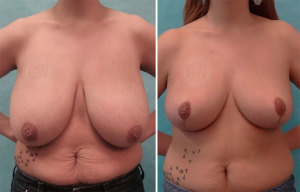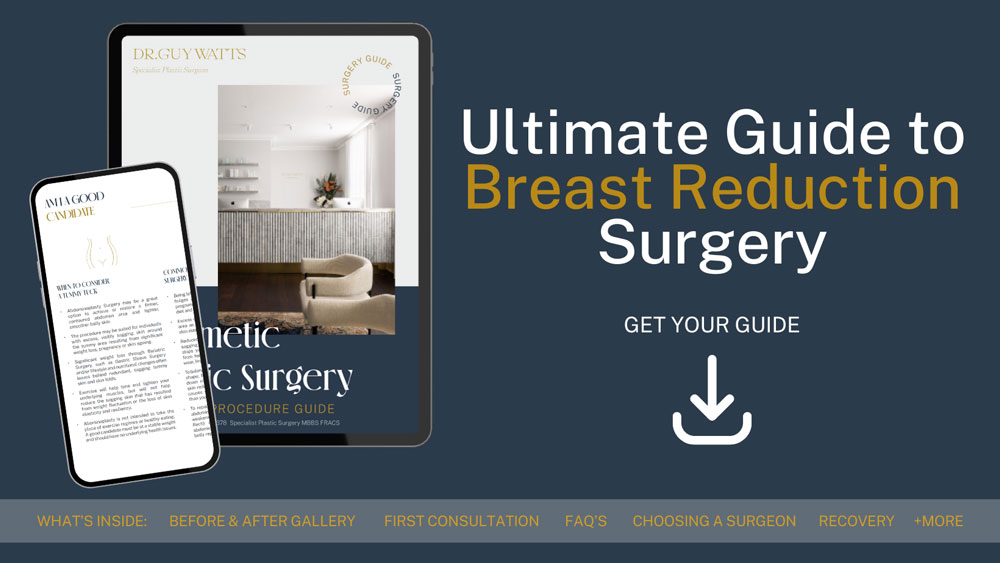BREAST REDUCTION

Before Breast Reduction Photo & 6 months After Photo
This website contains imagery which is only suitable for audiences 18+.


Before Breast Reduction Photo & 6 months After Photo
Breast Reduction surgery is a procedure designed to reduce the size and weight of large breasts. This surgery aims to achieve a breast size in proportion with your body and to alleviate the discomfort associated with overly large breasts.
Large breasts can cause both physical and emotional challenges for patients. Physically, individuals may experience back, shoulder and neck pain, skin irritation (redness, chaffing or rashes) under the breast crease, posture issues and even breathing problems.
The procedure involves the removal of excess breast fat, glandular tissue, and skin to achieve a breast size more in proportion with your body and to alleviate the discomfort associated with overly large breasts. The goal is to reduce breast size and alleviate discomfort, so breasts are more proportionate with the rest of their body.
Good candidates for Breast Reduction surgery are typically those who are experiencing physical discomfort due to the size of their breasts. It’s important that candidates have realistic expectations about what the surgery can achieve.
You may be a suitable candidate for Breast Reduction surgery if you:
Breast Reduction surgery can be performed at any age, but it is usually advised to wait until breast development has stopped. Pregnancy and breastfeeding can have significant and unpredictable effects on the size and shape of your breasts.
Breast Reduction surgery has changed significantly over the past decade. The basis of Dr Watts’ technique is a Vertical Breast Reduction procedure. This technique enables the ability to reposition the nipple areolar complex, reduce the breast volume, implement the lift and address the breast shape while reducing the visible appearance of the scar. This incision usually extends around the areolar with a vertical incision extending below the areolar. A short horizontal incision may be added within the breast crease but this is significantly shorter than traditional techniques. A Traditional Breast Reduction is reserved for the largest of volume reductions and entails a longer horizontal extension. Regardless of which technique is required Dr Watts and his team will guide you through their postoperative protocol for scar management to optimise healing and reduce scar visibility.

Dr. Watts is proud to provide before and after photos of individuals that have undergone Breast Reduction Surgery with him.
Photographs shown on this website are of actual patients who have given permission to have their photos published. They are for illustrative purposes only and have not been manipulated in any way. Individual results may vary and depend on several factors including body type, skin health, genetics, recovery, lifestyle factors and more.
The images may contain nudity and are not intended for persons under the age of 18. Viewer discretion is advised.
Dr Watts will often perform this procedure with liposuction to further contour the shape of the breast and reduce fullness under the arm.
Breast Reduction surgery is performed under general anaesthesia and can take between two to three hours, depending on the extent of the reduction. The procedure involves several steps:
Dr Watts typically performs Breast Reduction procedure on an inpatient basis (meaning you will stay in hospital after surgery) under general anaesthesia. The length of the procedure will depend on many factors, including surgical technique chosen, extent of reduction and other factors, but on average will take 2-3 hours to complete. Dressings will be placed over the breasts and a firm supportive bra applied after the procedure. Patients will generally remain in hospital overnight for observation and once recovered satisfactorily will be allowed to return home with a friend or family member.
The recovery process following Breast Reduction surgery is crucial for achieving the optimal results:
Written procedure specific information sheets will be given to you in order for you to prepare for both your surgery and the recovery period. You may experience moderate discomfort after the procedure and so a postoperative analgesia regime will be tailored to meet your specific needs. In general, you can expect most bruising, tenderness and swelling of the breasts to settle within 2 weeks.
Dr Watts and his team are dedicated to providing ongoing care, support and guidance throughout your entire experience. They will be readily available to answer any further questions you may have during your recovery. For more information please call our office to schedule a personal consultation with Dr Watts.
Plastic surgery comes with inherent risks. It’s crucial for patients to be aware of potential complications and make informed decisions. Anaesthesia is used in most surgical procedures for safety and comfort. However, in rare cases, it can lead to complications such as allergic reactions, lung infections, stroke, and even heart complications.
It is also important to keep in mind that all invasive surgeries result in some form of scarring. While Dr. Watts often uses techniques to reduce and strategically place these scars, some patients might experience hypertrophic or keloid scarring, which is a raised and more prominent scar. It’s essential for anyone considering plastic surgery to thoroughly research and understand these risks.
Read more about risks and potential complications of plastic surgery.
Any surgical or invasive procedure carries risks. Before proceeding, you should seek a second opinion from an appropriately qualified health practitioner.
Dr. Guy Watts is a Specialist Plastic Surgeon (AHPRA MED0001539378) with an extensive career that spans across renowned plastic surgery clinics worldwide. His experience has been honed through invaluable experiences at esteemed establishments such as the New York Eye and Ear Infirmary and the renowned Pitanguy Clinic in Brazil.
Having collaborated with the foremost cosmetic plastic surgeons on a global scale, Dr. Watts has chosen to return to Perth after a 17-year journey of intensive training and invaluable professional experience to bring the latest practices and technology in cosmetic plastic surgery to his patients.
Dr. Watts is a Fellow of the Royal Australasian College of Surgeons (FRACS) and a Member of the Australian Society of Plastic Surgeons (ASPS), Australasian Society of Aesthetic Plastic Surgeons (ASAPS) and the International Society of Aesthetic Plastic Surgeons (ISAPS).
Read about the potential Risks and Complications of Surgery
Read the Patient Information and Resources
Clinispa is Dr Watts’ bespoke medical clinic performing Cosmetic Aesthetic treatments. At Clinispa, we offer advanced clinical treatments in a luxurious and calming environment, tailored to support your skin’s health and appearance.
Clinispa aesthetic services are performed by Dr Guy Watts’ nursing professionals, who have a passion for and solid understanding of facial aesthetics.
All Clinispa clients are considered individually, with a personalised treatment plan consisting of advanced scientific approaches to cosmetic aesthetics. We incorporate innovative technologies in conjunction with superiorly formulated skin care.
For more information about the full range of Clinispa Aesthetic of Cosmetic Treatments visit the Clinispa website
Dr Robert Owen is a Specialist Plastic Surgeon (AHPRA MED0001546983) consulting at Dr Watts clinic in Ventnor Ave, Perth. He performs Breast, Body, Face and Skin Cancer surgery.
After obtaining his Medical Degree in the UK, he moved to Perth in 2005 to work in some of Perth’s Hospitals.
He was awarded his Fellowship of the Royal Australasian College of Surgeons in 2018. Dr Rob travelled overseas in 2019/20 for an International Surgical Fellowship and advanced training,
Dr Robert has a broad background in cosmetic and reconstructive plastic surgery and has an exceptional commitment to patient care.
Dr. Owen is a Fellow of the Royal College of Surgeons (FRACS) and a Member of the Australian Society of Plastic Surgeons (ASPS),